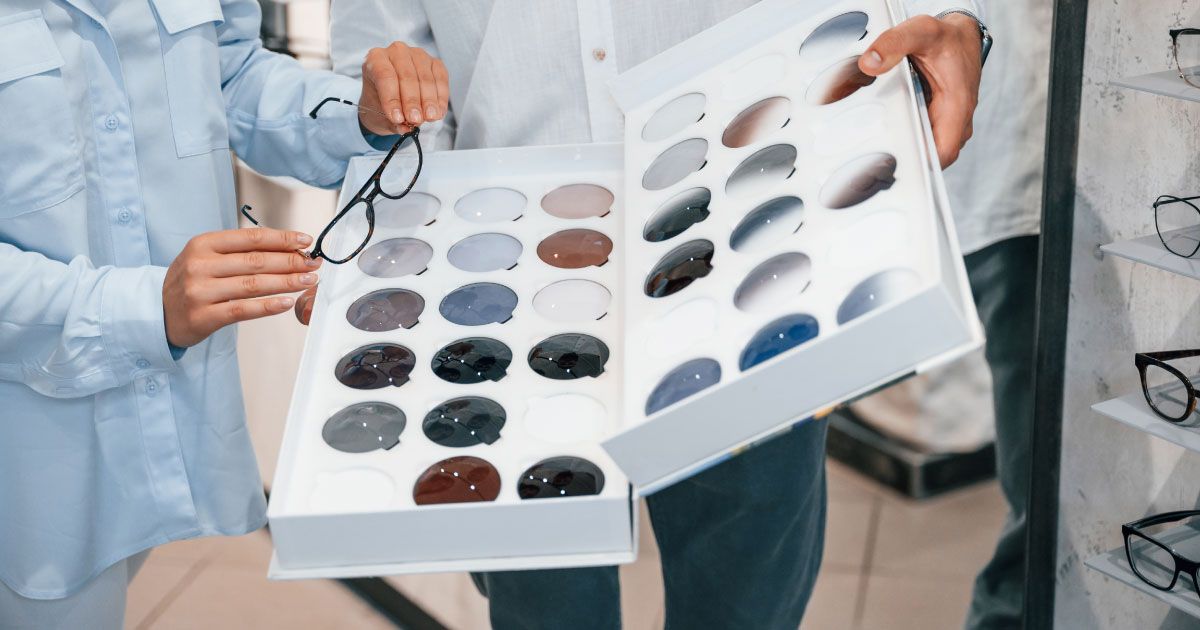Unlocking the Power of Lens Tints for Health and Well-Being

Read time: 6 minutes
Eyewear is often seen as a blend of fashion and function, but for many individuals, it also serves as a therapeutic tool. Specialized lens tints have been shown to provide relief from symptoms of various health conditions, ranging from migraines to light sensitivity, visual stress, and even seasonal mood disorders. By filtering specific wavelengths of light, these lenses can alleviate discomfort and improve quality of life.
Let's explore the science behind lens tints, how they work, and the specific health disorders they can help manage. Whether you’re seeking relief from eye strain, migraines, or other challenges, this guide will illuminate how tinted lenses might benefit you.
How Lens Tints Work
Lens tints are more than just cosmetic enhancements. They function by filtering out specific wavelengths of light that can cause discomfort, trigger symptoms, or impede visual performance. For example, certain tints block blue light, which can strain the eyes and disrupt sleep, while others enhance contrast and reduce glare to aid specific visual tasks.
Tinted lenses are available in prescription and non-prescription options and can be combined with coatings like anti-glare or polarized filters for added benefits. The choice of tint depends on the individual’s condition, environment, and visual needs.
1. Relief for Migraines and Light Sensitivity
Migraines affect millions of people worldwide, often accompanied by light sensitivity, also known as photophobia. For many, exposure to fluorescent lighting, computer screens, or bright sunlight can trigger or worsen migraine episodes.
FL-41 is a rose-colored tint designed specifically to block blue-green light wavelengths that are commonly associated with migraines. Studies have shown that wearing FL-41 tinted lenses can reduce the frequency and intensity of migraines, particularly for individuals with chronic light sensitivity.
How It Helps:
- Filters out flickering and harsh light from fluorescent bulbs.
- Reduces eye strain caused by computer and device screens.
- Lowers visual stress, a known migraine trigger.
Individuals who suffer from migraines should consult their eyecare provider about FL-41 lenses, as these can be customized to fit prescription glasses or non-prescription lenses.
2. Support for Dyslexia and Visual Stress
Dyslexia, a learning disorder that affects reading and writing, is often linked to visual stress - or and Visual Stress Syndrome. Some individuals with dyslexia report that words on a page seem to "swim" or blur, making reading a challenge.
Custom-colored overlays or tinted lenses tailored to an individual’s specific needs can help alleviate these visual distortions. By improving the contrast between text and background, these tints make reading more comfortable and less fatiguing.
How It Helps:
- Enhances clarity by reducing visual distractions.
- Improves focus and comprehension for individuals with dyslexia.
- Lessens headaches and eye strain associated with reading.
Eye care specialists often use a process of trial and error to determine the ideal tint for individuals with dyslexia, as the effectiveness of a color varies from person to person.
3. Managing Glare Sensitivity in Concussion Recovery
Concussions, a form of traumatic brain injury, can result in post-concussion syndrome, characterized by symptoms such as light sensitivity, headaches, and dizziness, with bright lights and glare often intensifying these issues and complicating daily activities.
Grey or amber-tinted lenses help reduce overall brightness and minimize glare, offering relief to individuals recovering from concussions.
How It Helps:
- Blocks intense light and glare from sunlight or artificial sources.
- Reduces headaches triggered by overstimulation of the eyes.
- Provides a soothing visual experience during recovery.
Amber tints are particularly beneficial as they enhance contrast without darkening the field of view excessively, making them suitable for indoor and outdoor use.
4. Combating Seasonal Affective Disorder
Seasonal Affective Disorder (SAD) is a type of depression that occurs during the darker months of the year when sunlight exposure is limited. The lack of natural light can affect mood, energy levels, and sleep patterns.
Yellow and orange tints create a sense of brightness and warmth, helping to counteract the effects of low light environments. These tints also enhance contrast, which can improve mood and visual performance.
How It Helps:
- Enhances brightness perception in low-light conditions.
- Creates a psychological sense of warmth and positivity.
- Reduces visual fatigue in dim environments.
While not a substitute for light therapy or professional treatment, yellow-tinted lenses can be a useful tool for managing SAD symptoms, particularly for individuals who spend long hours in dimly lit spaces.
5. Reducing Eye Strain from Digital Screens
With the rise of digital technology, many people experience Computer Vision Syndrome (CVS), a condition marked by eye strain, headaches, and blurred vision caused by prolonged screen use.
Lenses with blue light-blocking technology often feature a subtle amber tint. These lenses filter out high-energy visible (HEV) blue light emitted by digital devices.
How It Helps:
- Reduces digital eye strain and fatigue.
- Minimizes disruptions to circadian rhythms, improving sleep quality.
- Lowers glare from screens, improving visual comfort during extended use.
Blue light-blocking lenses are increasingly popular among office workers, gamers, and anyone who spends hours in front of screens. They are available as standalone lenses or as coatings applied to existing eyewear.
6. Enhancing Color Perception for Color Blindness
Color blindness, or color vision deficiency, affects an individual's ability to distinguish certain colors. This condition can make everyday tasks like reading traffic lights or selecting clothing difficult.
Specialized red-tinted lenses, such as those developed by EnChroma, help enhance color perception by filtering specific wavelengths of light. These lenses allow for better differentiation between red and green hues, the most common form of color blindness.
How It Helps:
- Enhances color discrimination for improved functionality.
- Boosts confidence in color-critical tasks.
- Provides a richer and more vibrant visual experience.
It’s important to note that these lenses do not "cure" color blindness but can significantly improve color recognition for many wearers.
7. Night Driving and Low-Light Vision
Driving at night can be challenging due to glare from oncoming headlights and reduced overall visibility. Some individuals experience halos or heightened sensitivity to bright lights in dark conditions.
Yellow-tinted lenses are designed to improve contrast and reduce glare, making them ideal for night driving or low-light activities.
How It Helps:
- Reduces glare from headlights and streetlights.
- Enhances contrast, improving depth perception.
- Minimizes eye strain during nighttime activities.
While yellow lenses can help in moderately low-light conditions, they may not be suitable for extremely dark environments as they slightly reduce overall brightness.
Choosing the Right Lens Tint for You
While lens tints can offer significant benefits, selecting the right tint requires careful consideration of your specific needs and lifestyle. A consultation with an eye care professional is essential to ensure that the chosen tint addresses your condition effectively.
Factors to consider include:
- Purpose: Are the lenses for medical relief, daily wear, or specific activities?
- Environment: Will they be used indoors, outdoors, or both?
- Combination Coatings: Anti-glare, UV protection, and polarization can enhance the effectiveness of tinted lenses.
The Urban Optiks Difference
At Urban Optiks Optometry, we understand the transformative power of precision eyewear. Our boutique combines advanced technology, expert craftsmanship, and a curated selection of luxury frames to offer you personalized solutions for both functional and aesthetic needs.
If you’re struggling with a health condition that may benefit from tinted lenses, we invite you to explore our range of specialized eyewear. Our experienced team will guide you through the process of selecting the perfect lenses to enhance your vision and improve your quality of life.
The Takeaway
Lens tints offer far more than a pop of color—they are powerful tools for managing a wide range of health conditions. From migraines to dyslexia, and beyond, the right lenses can make a world of difference. Contact Urban Optiks today to schedule a consultation and discover how we can help you see - and feel - better.
Share this blog post on social or with a friend:
The information provided in this article is intended for general knowledge and educational purposes only and should not be construed as medical advice. It is strongly recommended to consult with an eye care professional for personalized recommendations and guidance regarding your individual needs and eye health concerns.
All of Urban Optiks Optometry's blog posts and articles contain information carefully curated from openly sourced materials available in the public domain. We strive to ensure the accuracy and relevance of the information provided. For a comprehensive understanding of our practices and to read our full disclosure statement, please click here.


















